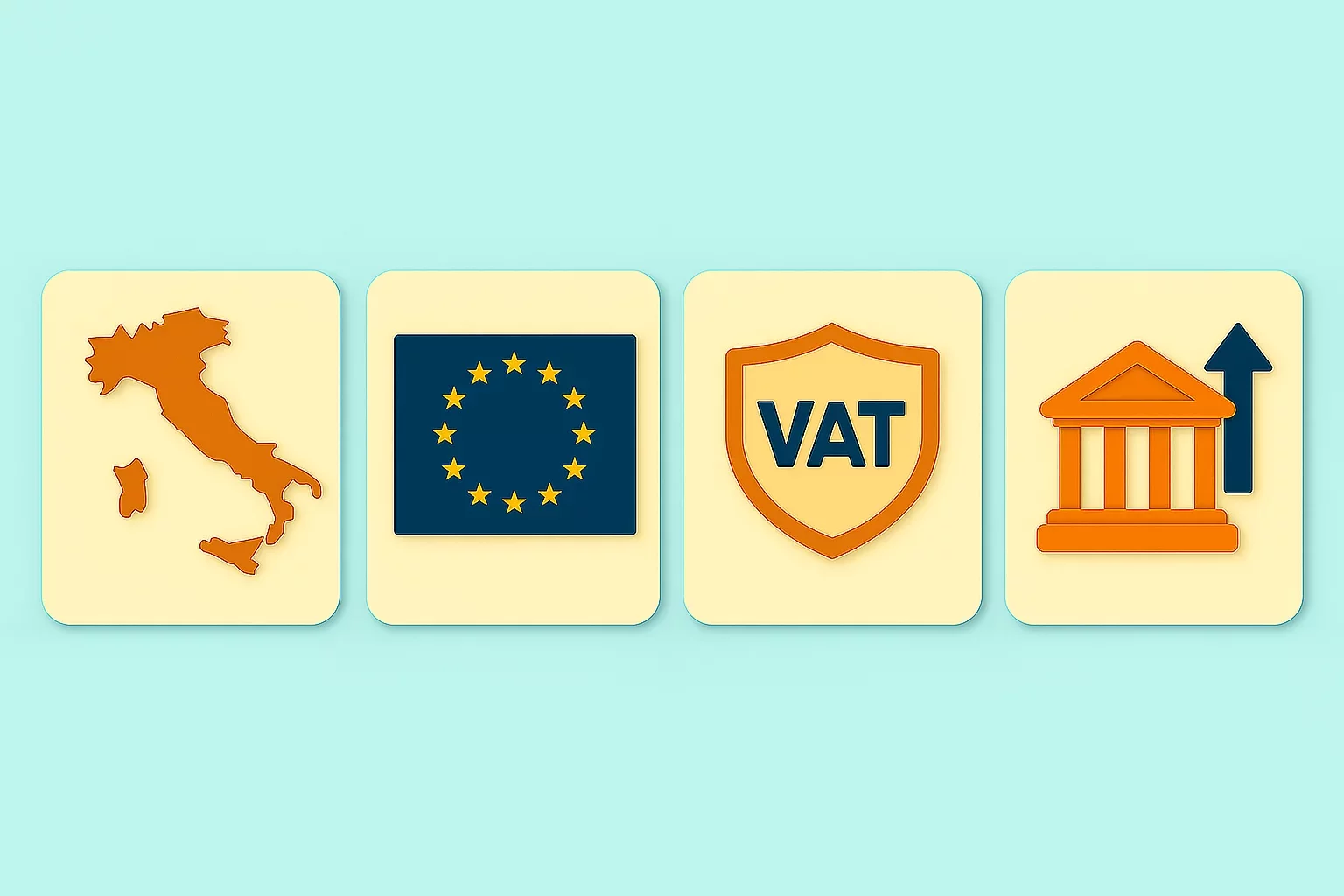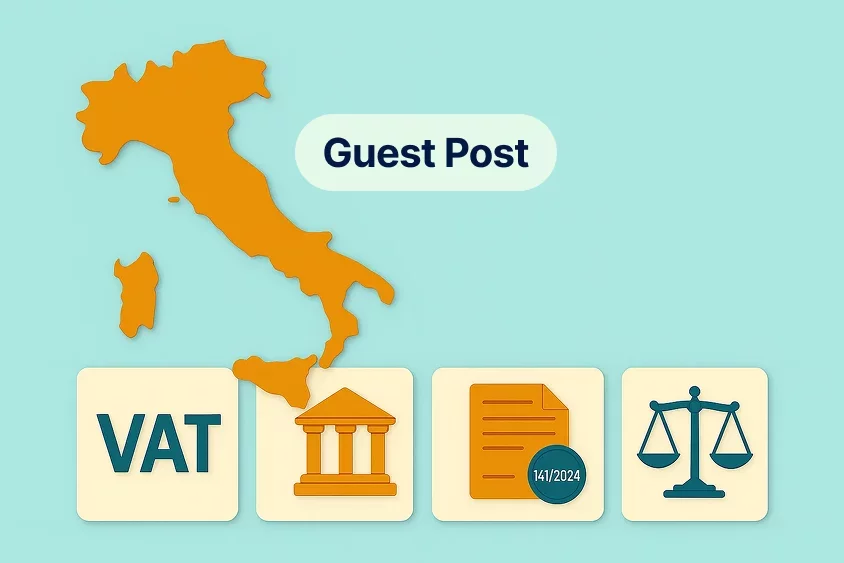Italy’s VAT Reform 2025: Key Changes Toward EU Harmonization

🎧 Prefer to Listen?
Get the audio version of this article and stay informed without reading - perfect for multitasking or learning on the go.
Italy is going through a historic review of its Value Added Tax (VAT) system, aiming for deep harmonization with European Union (EU) VAT principles. This transformation is part of a broader reform aiming to ensure compliance with EU directives and jurisprudence, increase legal certainty, simplify compliance, and improve the functioning of the market.
On 16 March 2023, the Italian government receive the power to revise and reorganize VAT legislation, with two important deadlines: the reform must be implemented by 29 August 2025, and formally completed by 31 December 2025. In July 2025, the Council of Ministers preliminarily approved a new consolidated VAT code including 171 articles divided across 18 sections.
Traditionally, Italy’s VAT framework has been described by Presidential Decree No. 633 of 1972 and Law Decree No. 331 of 1993. Over the years, conflicts between Italian national provisions and EU VAT law — particularly Council Directive 2006/112/EC — have created compliance difficulties and legal ambiguities.
Which are the fundamental pillars of the Reform?
1. VAT Scope and Conditions for applying the law
One of the most critical changes involves when VAT applies, especially regarding the concept of "supply of goods." Under current Italian law, a supply of goods requires the formal transfer of ownership under civil law. In contrast, the EU Directive focuses on the economic transfer of the right to dispose of goods. This more restrictive national interpretation has led to confusion and inconsistent treatment of transactions such as financial leasing and sale-and-leaseback agreements.
The ECJ has frequently emphasized that VAT rules should be read in light of economic substance rather than legal form. With the last reform the Italian legislator seeks to address these differences and bring Italy’s definitions in line with EU case law.
2. Rationalization of VAT Exemptions and Optional Taxation
A second point of the reform is the revision of VAT exemptions, particularly for the real estate and financial sectors. These sectors often involve mixed transactions—some taxable, some exempt—and suffer from uncertain legal interpretation. The reform proposes a clearer definition of exempt activities and introduces an “option to tax” mechanism in line with Article 137 of the VAT Directive even if it may trigger not so positive consequences for financial services and operators. The definition of exempted activities is not always so easy, as for example for the services related to the management of special investment funds that have long been subject to legal uncertainty in Italy. With reference to them, it is important to highlight that according to the ECJ exemptions should be interpretated strictly.
The ECJ has clarified that advisory services can be exempt if they are distinct, specific, and essential to fund management. The issue at this regard, will be the notion of management that is uncertain and not clarified neither from the VAT committee that in 2017 was already suggesting a case-by-case approach led by the taxable person.
3. Modernization of VAT Rates
Italy currently applies four VAT rates: 22% (standard), 10%, 5%, and 4% (reduced). The reform seeks to align these rates with the flexibility allowed under EU Directive 2006/112, which, at art. 98, permits reduced tax rates only to sales of goods and services foreseen in 24 points of Annex III of the Directive. The same article 98 states that tax rate below 5% can be applied to a maximum of 7 categories included in the Annex III of the Directive.
Future VAT rates will be determined using the Combined Nomenclature system, reducing ambiguity and lessening the Italian tax authority’s involvement in rate determinations. This move will bring greater transparency and legal predictability to VAT applications across a wide array of goods and services.
4. Changes in pro-rata mechanism
An ancient criticism of Italian VAT has been its rigid "general pro-rata" input VAT deduction system, which does not reflect the actual use of goods and services. Currently, if the taxpayer’s turnover can be divided between taxable and exempted activities but the taxpayer is able to demonstrate the link for almost all the purchased goods and services to supplies subject to VAT, it will be allowed to deduct a less amount of VAT due to the pro-rata functioning. Even if this mechanism has been considered compliant by the ECJ it seems to be not very in line with the principle of neutrality. (ECJ Case C-378/15, Mercedes Benz Italia SpA v. Agenzia delle Entrate Direzione Provinciale Roma 3, para. 50)
The reform proposes a dual approach: (i) a direct allocation method based on actual use of purchases and a specific pro-rata for goods and services of mixed use, and (ii) an optional general pro-rata system for simplification. This flexibility aims to enhance the accuracy of VAT recovery and align Italy with Article 173 of the VAT Directive, which allows member states to use use-based deduction systems.
5. Reform of Deduction Rights for Residential Property
Under current Italian law, VAT on expenses related to residential properties is non-deductible for businesses not primarily engaged in real estate. The new rules propose allowing deduction based on the actual use of the properties, which could significantly benefit companies involved in housing as a secondary activity.
6. Timing of VAT Deduction
Now, VAT can only be deducted within the deadline to submit the VAT return related to the fiscal year in which the invoice is received. The reform will allow businesses to choose whether to deduct VAT in the year it becomes chargeable or in the year the invoice is received. This change, especially relevant for end-of-year transactions, gives taxpayers more flexibility in managing cash flow and reporting obligations.
7. Simplification of the VAT Group Regime
The VAT group regime in Italy is currently governed by the "all in, all out" rule—once one entity in a corporate group opts in, all eligible entities must participate. The reform looks to a more flexible criteria for group formation, allowing selective inclusion and streamlining procedural requirements.
8. Import VAT Controversy
In parallel to the legislative reform, a significant judicial challenge has emerged. In July 2025, the Milan Second Instance Tax Court submitted a preliminary ruling to the ECJ (Case C-308/25, Isolanti Group), questioning whether Italy’s exclusion of import VAT from simplified tax dispute resolution mechanisms violates EU law. The case generates fundamental questions about neutrality and proportionality in VAT environment, particularly because domestic and intra-Community VAT claims can be settled with up to a 95% reduction in liability, while import VAT cases are excluded from this benefit.
The ECJ is being asked to determine whether this exclusion challenges the common system of VAT and the financial integrity of the EU, given that VAT constitutes a significant component of the Union’s own resources. A ruling in favor of the taxpayer could mean further efforts in reforms for the Italian legislator.
Conclusions
With the preliminary approval granted for the new consolidated VAT code and full implementation due by August 2025, Italy seems to be committed in resolving misalignment between national and EU VAT frameworks. The goal is to simplify compliance for individuals and taxpayers, giving them clarity about the concepts of exemptions and deductions by aligning the Italian legislation to EU rules and principles.
Italy’s VAT reform is more than just a domestic tax adjustment — it is a very good attempt to synchronize with a supranational fiscal vision grounded in uniformity, fairness, and economic rationality. As the final legislative steps unfold, all eyes will be on Italy and the Court of Justice of the European Union to see whether these ambitious goals will be realized in practice.

Featured Insights

Angola’s E-Invoicing Mandate: Phased Implementation Continues Into 2026
🕝 December 10, 2025
VAT Deduction and Business Succession: When Do Advisory Costs Serve the Company’s Interest?
🕝 December 8, 2025
Europe’s Plastic Fiscal Shift: Why Italy’s Plastic Tax Now Starts in 2027
🕝 December 3, 2025
The Decline of Low-Value Import Exemptions: Closing Gaps in Cross-Border E-Commerce
🕝 November 20, 2025More News from Italy
Get real-time updates and developments from around the world, keeping you informed and prepared.
-e9lcpxl5nq.webp)





-7xsxxoypnx.webp)
-o7f4ogsy06.webp)
-9mc55kqwtx.webp)
-jrdryw2eil.webp)
-t9qr49xs2u.webp)

-zetvivc79v.png)
-qizq6w2v5z.png)

-k1j4au0ph6.webp)
-ig9tutqopw.webp)







